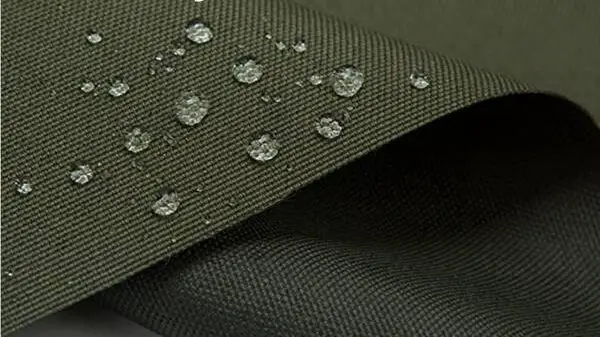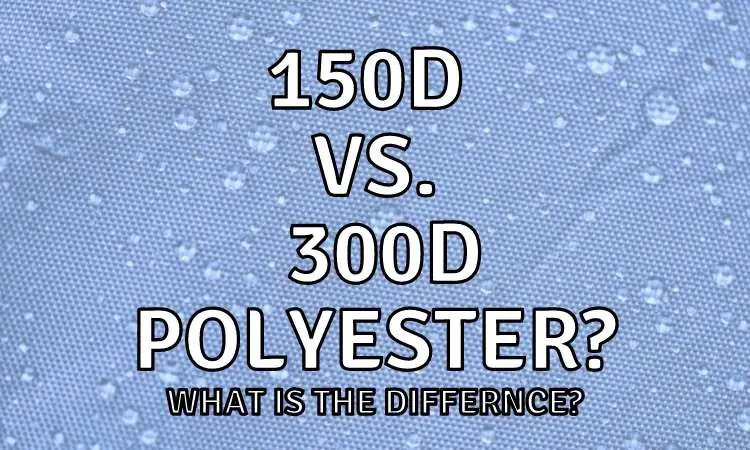Polyester is a synthetic plastic fabric often used for outdoor gear like jackets, backpacks, and tents. Along with nylon, it is the most common material to make up the flysheet and floor material of most camping tents today.
The difference between 150D and 300D polyester is in the thickness of the thread used to make the fabric. 150D thread weighs 16.7g per 1000m, whereas the thread of 300D polyester weighs 33.3 grams for the same length of thread. This makes 300D twice as thick as 150D polyester, which makes for a stronger fabric.
The “D” in these fabric designations stands for “denier” which is the weight of 9000 meters of thread. Alternatively, the designation “Tex” is also used for polyester fabrics and the conversion is as follows:
Tex = Denier/9
So for example, 300D polyester would also be called (300/9) 33T polyester and 150D is also named 16T.
Often the Tex designation is used for polyester rather than denier (which is more often used for nylon) as the threads of polyester are normally thicker and therefore the Tex measure gives a smaller number.
| Tex | Denier | Grams/meter |
| 30 | 270 | 0.03 |
| 50 | 450 | 0.05 |
| 70 | 630 | 0.07 |
| 100 | 900 | 0.10 |
| 150 | 1350 | 0.15 |
| 190 | 1710 | 0.19 |
| 210 | 1890 | 0.21 |
| 300 | 2700 | 0.30 |
Notice that the thread weight per kilometer is the same as the Tex value.
When it comes to the actual fabric, it is hard to compare directly between these numbers as they may be woven in different ways.
Also, technologies such as the “rip stop” cross-threading or different waterproofing coatings may be applied, which changes the weight, durability, and level of water resistance.
If you’re interested in truly lightweight tents, you should look to nylon and I have collected my favorites in this post about lightweight budget tents!
What is polyester?
Polyester is made from polyethylene terephthalate also known as PET, which is a synthetic polymer. The polyester plastic itself is used for in everything from drinking bottles to TV screens and insulation material for your sleeping bag or “down” jacket!

Garments made from thin threads of polyester are mostly used for clothing, furniture or tents.
Polyester is generally more suitable for outdoor clothing as it is cheaper, more resistant to wrinkling, discolors less in UV/sunlight, and is often regarded as more rough.
When used in outdoor products such as tents, thicker polyester threads are used because polyester is not as strong as nylon and therefore more polyester materials (thicker threads) are needed to obtain the same strength.
In addition, it is simply not technically possible to make polyester threads thinner than a thickness of 20D (whereas nylon can be spun down to 7D!).
This generally makes products with polyester, including tents, heavier than comparable products where nylon is used.
What is 150D polyester?
150D (or 33T) is a fairly thick polyester material that is fairly tough and waterproof.
The thread thickness is 150D polyester is 0.016 grams per meter and typical 150D polyester fabric weighs 100-160 grams per square meter when PU coated.
Due to its water resistance and relatively lightweight, it is used for clothing, backpacks, tents, and waterproof covers e.g. for bikes or cars.
What does 300D polyester mean?
Typical 300D polyester fabric of the oxford style weighs 120-180 grams per square meter, which is quite a lot more than most nylon fabrics.
However, the thicker nylons such as 210D, 420D, or 600D are similar in weight but quite a lot stronger.
Due to its high strength and water resistance, it is used for backpacks, umbrellas, and bike covers, rather than more weight sensitive applications like tents.
What is the difference between 150D and 300D?
300D polyester is roughly twice as thick as 150D polyester and therefore a tent made from 300D rather than 150D polyester would be more sturdy and likely more rainproof (depending on the coating technology and amount).
Whereas the 300D thread is twice as thick as the 150D thread, this does not mean that the fabric is twice as heavy as less thread is needed for the same area of fabric!
Therefore, as seen above, the fabric of 300D is only marginally heavier than that of 150D but still with a significantly higher (more than twice) strength!
If you want to know more about different types of polyester fabrics, see my recent post on 30D vs. 70D vs. 190T vs. 210D polyester materials often used for tents or the thicker nylon fabrics with similar uses as the polyesters mentioned in this article.
Polyester can also be used for other things than fabric – for example, insulating filling in jackets and sleeping bags!
What is 300D oxford fabric?
300D Oxford fabric is a type of fabric commonly used in outdoor and sports gear, backpacks, and luggage.
Oxford fabric is a type of woven fabric that has a basketweave structure, characterized by a shiny appearance and a rough texture.

The fabric is made of polyester, nylon, or a blend of the two, which makes it water-resistant and durable.
300D Oxford fabric is considered to be a mid-weight fabric, suitable for making bags, backpacks, and other products that require a balance of strength and flexibility. It is often coated with a layer of polyurethane (PU) or polyvinyl chloride (PVC) to enhance its water-resistant properties.
Overall, 300D Oxford fabric is a popular choice for manufacturers due to its strength, durability, and resistance to water and abrasion, making it ideal for outdoor and sports equipment.
Final words
The difference between 150D and 300D polyester is in the thickness of the thread used to make the fabric. The “D” in the fabric designations stands for “denier” which is the weight of 9000 meters of thread.
Polyester is generally more suitable for outdoor clothing, and when used in outdoor products such as tents, thicker polyester threads are used.
150D (or 33T) is a fairly thick polyester material that is fairly tough and waterproof, and it is used for clothing, backpacks, tents, and waterproof covers for bikes or cars.
300D polyester is roughly twice as thick as 150D polyester and therefore a tent made from 300D rather than 150D polyester would be more sturdy and likely more rainproof.
The fabric is only marginally heavier than that of 150D but still with a significantly higher strength.
Did you know that polyester is also widely used for rain gear, sleeping bags, tents, and sleeping pads?
If you would like to know how down compares to synthetic polyester filling for warmth See my newest analysis of polyester vs. down for warmth here (I think you will be surprised!).
And do you know how it impacts the functionality? I wrote an article about material impact on rain gear here.
Take a look at my favourite sleeping bags or check out how materials choice affects how noise a sleeping pad is, and how you choose an inflatable sleeping pad that is not noisy to sleep on?
Other materials like that of the extremely durable and waterproof Dyneema material is also used more and more in outdoor gear.






